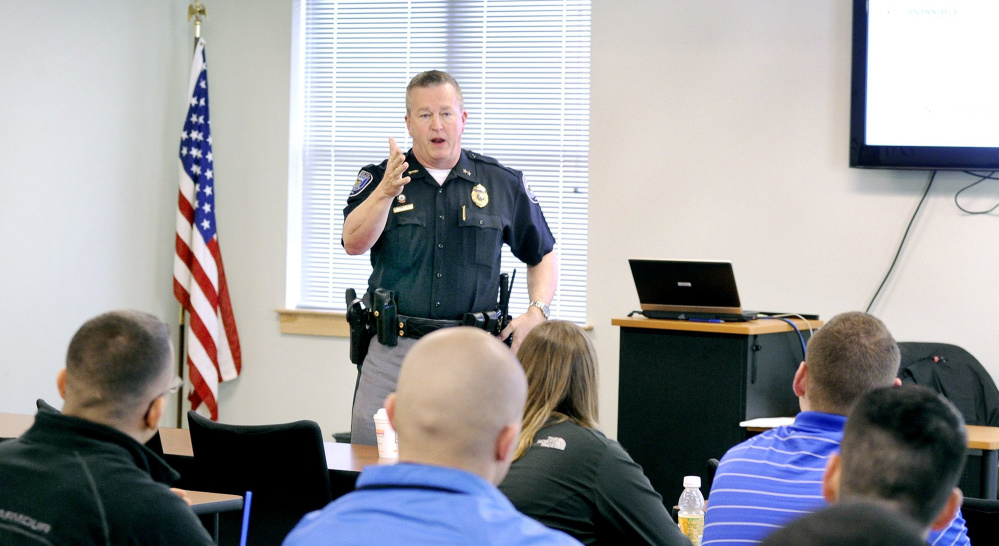In Sanford, in southern Maine, six people overdosed, including one dead, over the course of 24 hours. In Monmouth, in central Maine, three overdosed, one who remains on life support, at nearly the same time.
That’s the state’s heroin crisis at its most headline-grabbing, but it’s only part of the toll. Thousands of Mainers struggle with addiction every day, many of them while looking for help that just isn’t there. That’s been the crux of this devastating problem for years, and it remains so today, and until there are more treatment options, we’ll continue to see overdoses and deaths at an alarming rate.
‘AROUND AND AROUND’
Sanford Police Chief Thomas Connolly, for one, has had enough. Connolly, who has studied addiction extensively and sees its impact every day on the job, told the Press Herald, “We just go around and around and around with it. The simple solution is that we’ve got to have more low-cost outpatient treatment for these people everywhere, so that if people want to get help, they can get help.”
Connolly is right. For all the attention the heroin crisis has received, progress in fighting it has been slow. Police and treatment providers have done what they can, but even they have said it is clearly not enough.
The Legislature last session passed a series of anti-drug initiatives that represented a small step in the right direction. Once in place, the initiatives will ensure that a few more people who need help will get it, and perhaps that somewhat fewer drugs will get into Maine.
But the LePage administration has been slow to implement some of those initiatives and others related to heroin, some of which were approved more than a year ago. Just last week, the administration missed a deadline for distributing funds for a new detoxification center; a request for proposals is just now being sent out.
Administration officials have touted work being done on a new 200-bed facility to be built at the Maine Correctional Center in Windham. That could be a great use of treatment resources – the facility could help end the cycle of addiction and crime that puts a lot of people in prison. But it targets only the prison population, and it won’t be built for three to five years.Help is needed now. Unfortunately, none of the initiatives approved so far targets in a meaningful way the most significant problem – the lack of options related to medication-assisted treatment, such as methadone.
That is proven to be the best course of treatment, but unfortunately it is the subject of political controversy, making it a difficult sell in the Legislature.
But we can’t forget that, right now, there are people seeking treatment who cannot find it. The longer they have to wait, the less likely it is that they will make it. By not giving them a way out when they are ready for it, we extend the crisis, person by person, and make it far more likely that the individual’s story will end up on the front page, or in the obituaries.
NO TIME TO WAIT
The people on the ground in this crisis can see it clearly. The director of a methadone clinic in Bangor, one that is trying to expand from 300 beds to 500, told the Bangor Daily News that the clinic has a wait list of 173 patients, some of whom have been waiting for more than 120 days. The clinic receives at least three to five new requests every day, the director said.
The drug problem is infinitely complex, and there is no consensus on how to best address it.
But at its heart are people with a real illness, however difficult it is to understand. They need help – right now, today – and it’s not there.
That can be changed. It has to be, or we’ll keep seeing stories like the ones out of Sanford and Monmouth, just in a different community.
Send questions/comments to the editors.



Success. Please wait for the page to reload. If the page does not reload within 5 seconds, please refresh the page.
Enter your email and password to access comments.
Hi, to comment on stories you must . This profile is in addition to your subscription and website login.
Already have a commenting profile? .
Invalid username/password.
Please check your email to confirm and complete your registration.
Only subscribers are eligible to post comments. Please subscribe or login first for digital access. Here’s why.
Use the form below to reset your password. When you've submitted your account email, we will send an email with a reset code.